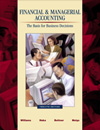Chapter 16 - Summary LO 1 Explain the three principles guiding the design of management accounting systems. First, management accounting systems help to decide who has the decision-making
authority over company assets. Second, accounting information produced or created
from the management accounting system supports planning and decision making.
Finally, management accounting reports provide a means of monitoring, evaluating,
and rewarding performance. LO 2 Describe the three basic types of manufacturing costs. Direct materials used consist of the parts and materials that become part of
the finished products. Direct labor cost consists of the wages paid to factory
employees who work directly on the products being manufactured. Manufacturing
overhead includes all manufacturing costs other than the cost of materials used
and direct labor. Examples of manufacturing overhead include depreciation of
machinery and the plant security service. LO 3 Distinguish between product costs and period costs. Product costs are the costs of creating inventory. They are treated as assets
until the related goods are sold, at which time the product costs are deducted
from revenue as the cost of goods sold. Thus goods manufactured this year but
not sold until next year are deducted from next year's revenue. Period costs are charged to expense in the accounting period in which they
are incurred. Period costs are not related to production of goods; consequently,
they are deducted from revenue on the assumption that the benefits obtained
from the expenditures are received in the same period as the costs are incurred.
Period costs include general and administrative expense, selling expense, and
income taxes expense. LO 4 Describe how manufacturing costs flow through perpetual inventory accounts. Manufacturing costs originally are recorded in three controlling accounts:
Materials Inventory, Direct Labor, and Manufacturing Overhead. As these costs
become applicable to goods placed into production, they are transferred from
these manufacturing cost accounts to the Work in Process Inventory account.
As units are completed, their cost is transferred from the Work in Process account
to Finished Goods Inventory. Then, when units are sold, their costs are transferred
from Finished Goods Inventory to the Cost of Goods Sold account. LO 5 Distinguish between direct and indirect manufacturing costs. Direct manufacturing costs (direct materials and direct labor) can be identified
with specific products. Indirect manufacturing costs are the many elements of
manufacturing overhead that apply to factory operations as a whole and cannot
be traced to specific products. LO 6 Explain the purpose of overhead application rates and the importance of basing
these rates on significant cost drivers. An overhead application rate is a device used to assign appropriate amounts
of overhead costs to specific units of output (manufactured products). Overhead
is an indirect cost, which cannot be directly associated with specific output.
However, the overhead application rate expresses the relationship between overhead
costs and some activity base that can be traced directly to specific units.
The activity base should be the major driver (causal factor) of overhead costs;
if the activity base is not the cost driver, the relative production cost of
different products may be significantly distorted. LO 7 Prepare a schedule of the cost of finished goods manufactured. This schedule summarizes the flow of manufacturing costs into and out of the
Work in Process Inventory account. Its purpose is to assist management in understanding
and evaluating manufacturing costs incurred in the period. To prepare this schedule, we start by listing the work in process inventory
at the beginning of the year. To this amount we add the materials used, direct
labor costs, and overhead for the period. Combining these four items indicates
the total cost of all work in process during the period. A final step is deducting
the cost of work still in process at the end of the period. This gives us the
cost of finished goods manufactured during the period. The terminology and concepts introduced in this chapter will be used extensively
throughout the remaining chapters in this text. | 


 2002 McGraw-Hill Higher Education
2002 McGraw-Hill Higher Education